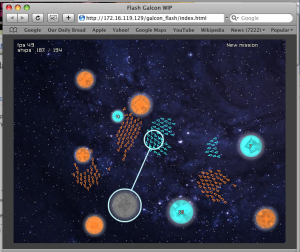Updates – I’ve got it all fitting in 64k*. It’s amazing how many functions that don’t do anything you can come across if you look around long enough. Not to mention how many little things you can trim out that don’t actually do anything. I have no idea where all this cruft comes from, but having a nice suite of tests sure is helpful for re-working stuff. I also cut out a bunch of stupid features nobody would ever use**. I was able to reduce the number of native types from 9 to 7.
One of the challenges I faced was trying to fix up the incremental garbage collection. My initial implementation was rather inefficient and caused some odd problems with how I wanted to code things. I was using a dict to store all the “white” items, which caused loads of dict hash lookups.
So in my mind I crafted a grand vision on how to accomplish this goal. I would adjust all objects (sans numbers) to contain a pointer to some data which would have some header data for the GC to do some bookkeeping in. Great! However, when I implemented this, I found that a number of problems presented themselves: I had to perform a malloc for each and every string that I used, which killed performance, actually making things 2-3x slower. I also noticed that the weird struct I defined was maybe a bit less standards compliant. This attempt was a wash.
So I re-crafted my grand vision. This time I would do the same thing. Brilliant aren’t I? Anyway, the results were basically the same. Who’d’ve thunk? It was slower again, this time I was quite confused by it, since I had worked around some of the string issues. I also found that the API for creating new strings wasn’t quite as “clean” as my original simple one. This caused some issues in the exception handling mechanism. I had to toss this try as well.
At this point, having re-mangled the code twice and having poor results, I suspected something else might be wrong. My brain was turning into mush. Each time I had completely edited my “tp.h” with all my struct changes in one go. I decided to make a final attempt at reworking tinypy, this time *one* data type at a time. After each data type I added I was able to see if my changes caused any performance issues. I found that my function data type was the culprit. My hashing function (borrowed from lua) wasn’t getting enough entropy and was generating massive collision cases! A few tweaks later, this was resolved. I was able to also craft the string interface to be backwards compatible with the original string interface while also working with the new garbage collection. This “step by step” approach got me to my goal. All said and done, with a bit more tweaking, I was able to *double* the speed of tinypy 🙂
Lesson learned – even if it’s only 64k, it’s better to do changes step by step instead of in one big go. valgrind and callgrind are your friends. (Although I found that tinypy doesn’t entirely agree with callgrind … ideas anyone?)
To wrap up this excessively long post about me trying to get code to work — this weekend I’m hosting a Ludum Dare warmup compo. I’m going to give tinypy a run in the “real world”. Here’s to hoping! Next week I plan on releasing the 1.0 version of tinypy.
I’m also thinking about renaming some of my files. And although pylang, dumbparse, and dump2vm have a certain rustic charm, I wonder if I’d do better with names like goat, gorilla, and sausage. Or maybe more descriptive names like tokenator, parsalizer, and bytecodatron.
svn://www.imitationpickles.org/tinypy/trunk for the brave. If you want a zip or an exe, check back in a week. I’ll have all those and more (a game!) Note that I’ve split the SDL dependency out of the main tinypy code. tinypy-sdl.c lets you run my julia.py example. The bootstrapping process also has a final step of compiling with -O3, which I think might not work for everyone. It gives pretty good speed gains on my system, so if it works for you, great!
*python mk64k.py will do a bit of search-n-replace to cut it down to size. I’ve resisted doing anything really ghastly, the code is still indented and readable. See README.txt for more disgusting details on how I cheat to pretend this is 64k.
**Okay, I’ve used some of those features. But hey, this is a 64k implementation, I’ve got to trim the fat.






